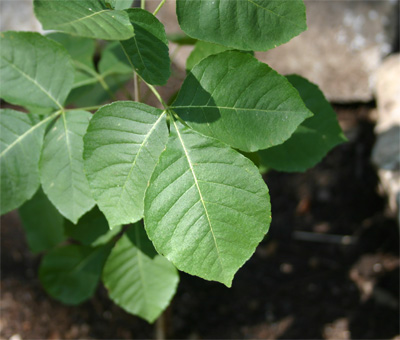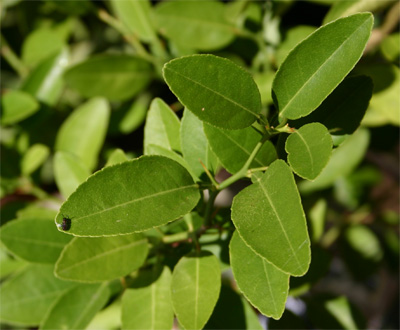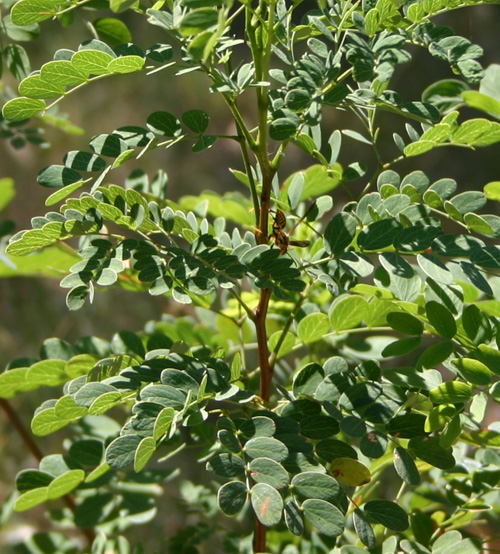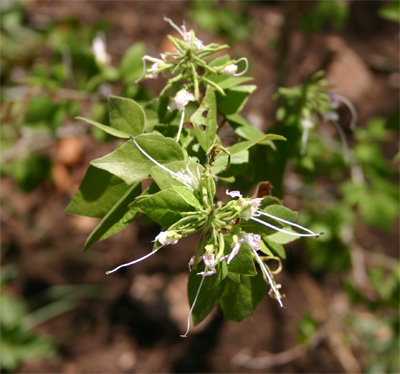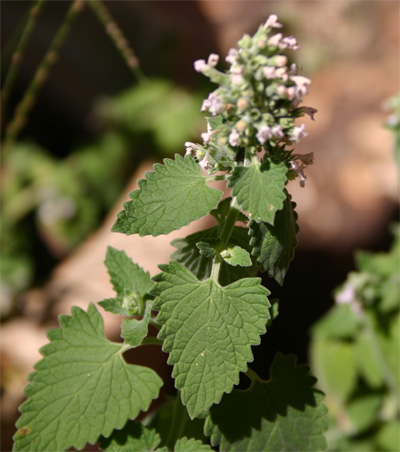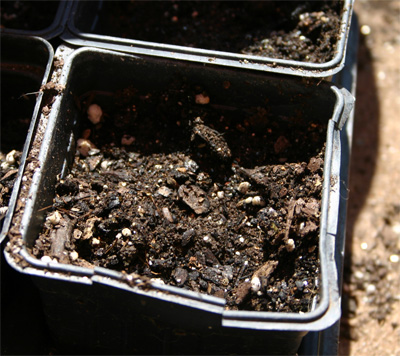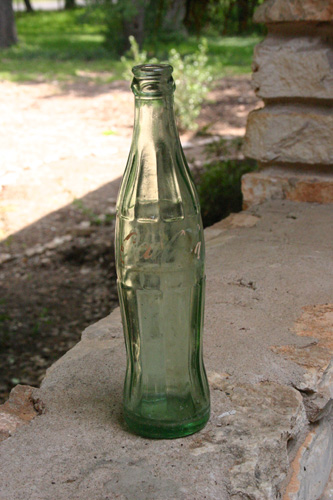I think I need a better name than Pumpkin Army — this veggie gardening endeavour just gets bigger and bigger. I’ve now added corn to the plan. Alas. This is what research does for you! It also gets you: trellises!
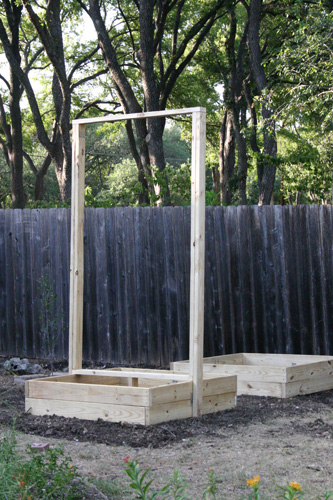 I’m back from camping. It was good fun — and nice to have a change of pace. I’d like to say that all my plants survived my absence, but I’m happy that most of them did (mourning the rest). The seedling army grows.
I’m back from camping. It was good fun — and nice to have a change of pace. I’d like to say that all my plants survived my absence, but I’m happy that most of them did (mourning the rest). The seedling army grows.
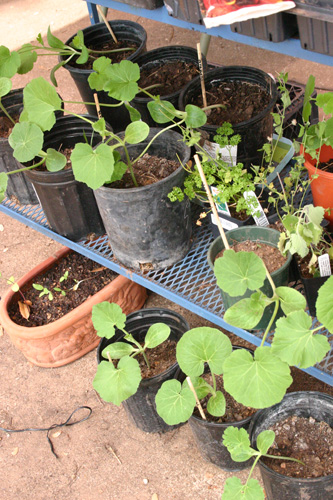 And of our three swallowtail caterpillars happily munching away before we left, we found one chrysalis, so we’ll try to monitor it for butterfly-ness. Of course, it’s in a place that is very hard to get a picture, and it’s also in a place that the butterfly will have a hard time getting out of without our help.
And of our three swallowtail caterpillars happily munching away before we left, we found one chrysalis, so we’ll try to monitor it for butterfly-ness. Of course, it’s in a place that is very hard to get a picture, and it’s also in a place that the butterfly will have a hard time getting out of without our help.
Though my DH didn’t quite get to all the plants, he certainly tried, and it was nice to return home to additional hoses and hand sprinklers so that I don’t have to drag hoses around to water those plants far away from civilization, my house. (It’s not that I hadn’t thought of it, I just was trying to avoid spending the money!) In addition, he made great progress on the raised garden beds, which means I will soon have the cantaloupes happily planted.
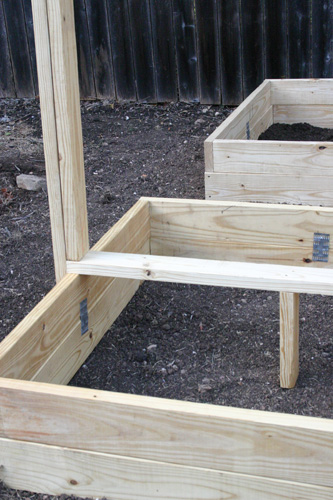 The jack-o-lantern pumpkins are going to be spread around the yard and will have to brave possible trampling by dogs, scary because the vines are so important to the size and quality of the pumpkins. I’ve got three jack-o-lantern pumpkins in the ground now, with more to come, maybe. I put them in little mounds, and for now I surrounded them with rocks to help the dogs avoid them. One of them is near some other plants, so I’ll have to guide the vines other directions, as best I can. It will have to do — those vines are growing so fast that I wanted them in the ground as soon as possible. I’ll get some marigolds and radishes near them for bug repellents. It’s apparently not the right season to grow radishes, but if they’ll keep the bugs away, I’ll try!
The jack-o-lantern pumpkins are going to be spread around the yard and will have to brave possible trampling by dogs, scary because the vines are so important to the size and quality of the pumpkins. I’ve got three jack-o-lantern pumpkins in the ground now, with more to come, maybe. I put them in little mounds, and for now I surrounded them with rocks to help the dogs avoid them. One of them is near some other plants, so I’ll have to guide the vines other directions, as best I can. It will have to do — those vines are growing so fast that I wanted them in the ground as soon as possible. I’ll get some marigolds and radishes near them for bug repellents. It’s apparently not the right season to grow radishes, but if they’ll keep the bugs away, I’ll try!
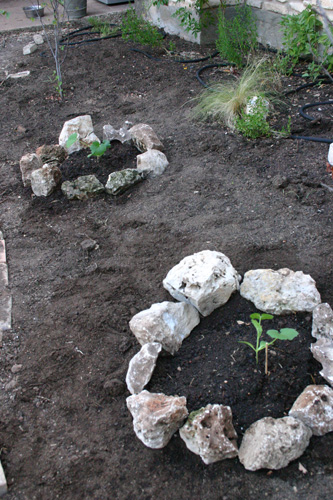 The cantaloupes will be in a raised garden bed, grown vertically on a trellis. All in all, we’ll have three raised veggie beds (for now, haha). The cantaloupes will be in one, along with corn and some marigolds, and sugar pumpkins will be in another, with some more corn. The third bed will be prepared for yummy fall planting goodness. The third bed was made for me by my kids this weekend, their first project working with drills and saws and whatnot!
The cantaloupes will be in a raised garden bed, grown vertically on a trellis. All in all, we’ll have three raised veggie beds (for now, haha). The cantaloupes will be in one, along with corn and some marigolds, and sugar pumpkins will be in another, with some more corn. The third bed will be prepared for yummy fall planting goodness. The third bed was made for me by my kids this weekend, their first project working with drills and saws and whatnot!
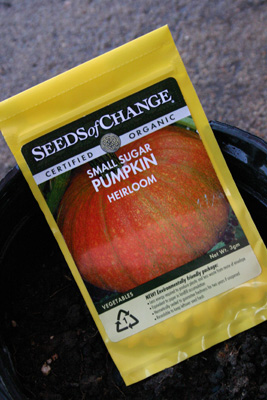 To prepare the area, we dug out the grass. It was dead, so other than dealing with the hard soil, it was no loss and only somewhat of a pain. Then, with the frames in place, I mixed in compost into the existing soil. I expect some plant roots to extend into that soil, so I wanted to enrich it somewhat. How hard was the soil? Casualty, one shovel.
To prepare the area, we dug out the grass. It was dead, so other than dealing with the hard soil, it was no loss and only somewhat of a pain. Then, with the frames in place, I mixed in compost into the existing soil. I expect some plant roots to extend into that soil, so I wanted to enrich it somewhat. How hard was the soil? Casualty, one shovel.
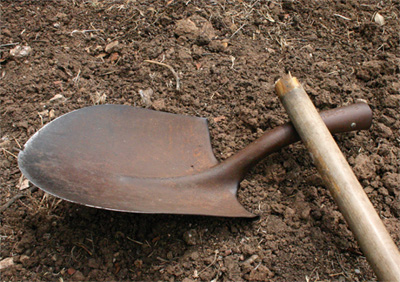 For the main bed soil, I decided to follow “Mel’s Mix” for square-foot gardening. I talked with the folks at Natural Gardener before doing this, and they had various suggestions (including Mel’s Mix), but nothing really any better or worse. The other option I considered was mixing compost with more of my clay soil, but that would have involved more digging. Forget that! Once I got the stuff home, I read on the bag about dust concerns with the vermiculite, and I felt a little concerned that I’d made a bad choice, but a little more research online made me feel better.
For the main bed soil, I decided to follow “Mel’s Mix” for square-foot gardening. I talked with the folks at Natural Gardener before doing this, and they had various suggestions (including Mel’s Mix), but nothing really any better or worse. The other option I considered was mixing compost with more of my clay soil, but that would have involved more digging. Forget that! Once I got the stuff home, I read on the bag about dust concerns with the vermiculite, and I felt a little concerned that I’d made a bad choice, but a little more research online made me feel better.
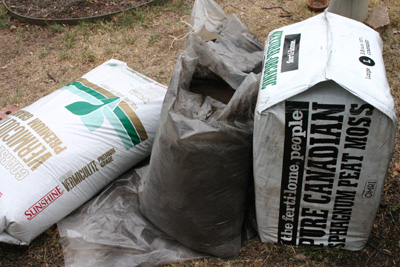 In mixing the soil, I felt a lot like Hermione in front of a big cauldron at Hogwarts. It was fun mixing it, I admit. I did add in some bonus clay soil from a pile in the yard, for good measure. It’s that secret ingredient in my special sauce.
In mixing the soil, I felt a lot like Hermione in front of a big cauldron at Hogwarts. It was fun mixing it, I admit. I did add in some bonus clay soil from a pile in the yard, for good measure. It’s that secret ingredient in my special sauce.
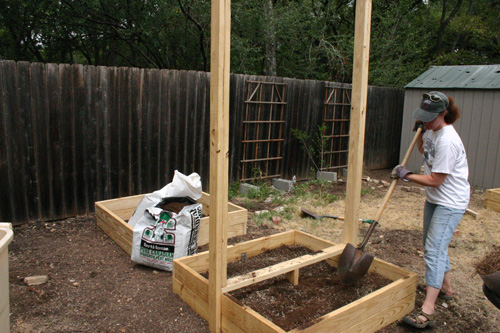
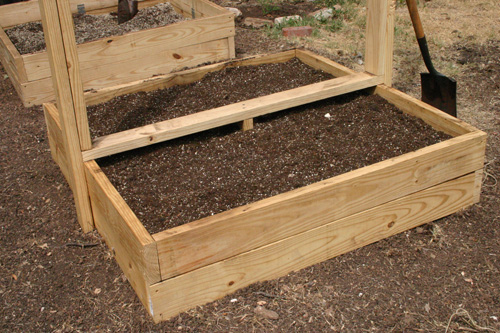 Because someone at NG told me that peat moss can be a pain to get wet at first, I decided to wet down the soil well and plant tomorrow. Sure enough, I had to work with the peat moss in a big soup of mud to get it to soak in the water. Then I really did feel I was creating a magical potion! Tomorrow will be a good planting day. First I’ll get the trellis wires in place and the grid. Then in will go the cantaloupes and marigolds and some corn seeds.
Because someone at NG told me that peat moss can be a pain to get wet at first, I decided to wet down the soil well and plant tomorrow. Sure enough, I had to work with the peat moss in a big soup of mud to get it to soak in the water. Then I really did feel I was creating a magical potion! Tomorrow will be a good planting day. First I’ll get the trellis wires in place and the grid. Then in will go the cantaloupes and marigolds and some corn seeds.
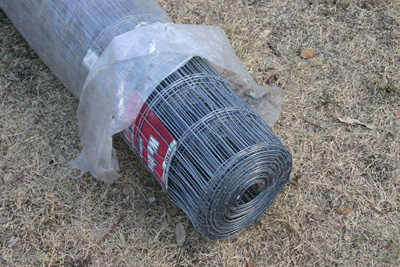 Side story… While I was digging the soil for the frames, I found a weird, soft little tube. At first I thought that it was, pardon me, some old dog poop. But then it split open, and a spider carcass fell out. Squeal. And then lots of little spiders came out and crawled over the spider carcass. Shriek! While I was wondering whether they had eaten the spider, more horrors awaited me… the legs of a gigantic spider appeared. And they MOVED. And more baby spiders crawled out and over the legs… By now, I’d made loud enough noises that the kids came running over. And finally the whole spider slid out, and it was the biggest spider I’d ever seen in my yard. Yes, tarantulas are even bigger, but I haven’t seen one as a resident yet. Despite my startled reaction to the sudden appearance of this spider and her babies, I find her beautiful. Can you see some of her babies in this picture?
Side story… While I was digging the soil for the frames, I found a weird, soft little tube. At first I thought that it was, pardon me, some old dog poop. But then it split open, and a spider carcass fell out. Squeal. And then lots of little spiders came out and crawled over the spider carcass. Shriek! While I was wondering whether they had eaten the spider, more horrors awaited me… the legs of a gigantic spider appeared. And they MOVED. And more baby spiders crawled out and over the legs… By now, I’d made loud enough noises that the kids came running over. And finally the whole spider slid out, and it was the biggest spider I’d ever seen in my yard. Yes, tarantulas are even bigger, but I haven’t seen one as a resident yet. Despite my startled reaction to the sudden appearance of this spider and her babies, I find her beautiful. Can you see some of her babies in this picture?
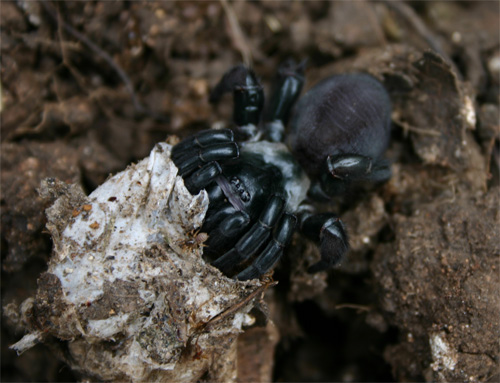 It turns out this spider is a female trapdoor spider, and she creates a silk tube-like burrow for hunting purposes, laying eggs, and feeding young. I felt some major guilt about disrupting this little family. But once the babies left the tube, all I could do was scoop up (with the shovel) some of the dirt they crawled upon and get them to a prepared garden bed instead of letting them get buried under the dirt I was lifting and turning. The mom spider went to a shady spot, because she looked so shiny and that “carcass” I saw was probably her molted exterior. Or perhaps her mate, eep!
It turns out this spider is a female trapdoor spider, and she creates a silk tube-like burrow for hunting purposes, laying eggs, and feeding young. I felt some major guilt about disrupting this little family. But once the babies left the tube, all I could do was scoop up (with the shovel) some of the dirt they crawled upon and get them to a prepared garden bed instead of letting them get buried under the dirt I was lifting and turning. The mom spider went to a shady spot, because she looked so shiny and that “carcass” I saw was probably her molted exterior. Or perhaps her mate, eep!
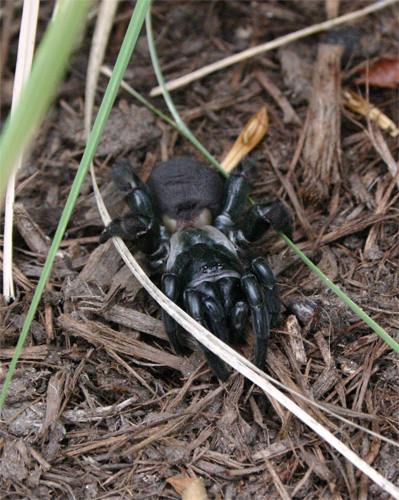 Hopefully they’ll survive. Guilt, guilt. Live, spiders, and go eat my pest bugs!
Hopefully they’ll survive. Guilt, guilt. Live, spiders, and go eat my pest bugs!
Speaking of horrific creepy-crawlies, check out this bug I found in Oklahoma. At first I saw beautiful wings and thought it was a really unique and large moth. But then I saw the head and its enormous pincher-like mouth. My guess is it’s not a moth! This bug was more than 3 inches long, front to end. Imagine this bug about the size of a house. It’s got B-movie horror written all over it! Edit: I googled and determined that this is a female dobson fly. Takes some of the fun out, knowing the name, doesn’t it? 🙂
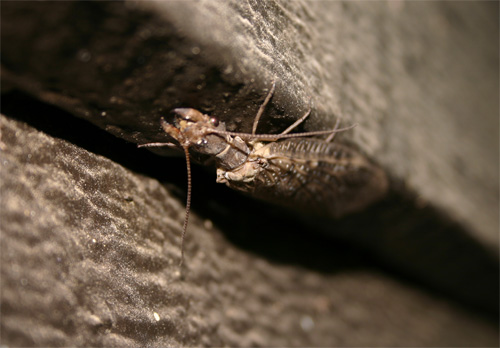 We saw a pretty cool leaf butterfly of some sort there, too, and many spiders. This picture didn’t turn out as well as I’d like, but I like the overall effect of the image.
We saw a pretty cool leaf butterfly of some sort there, too, and many spiders. This picture didn’t turn out as well as I’d like, but I like the overall effect of the image.
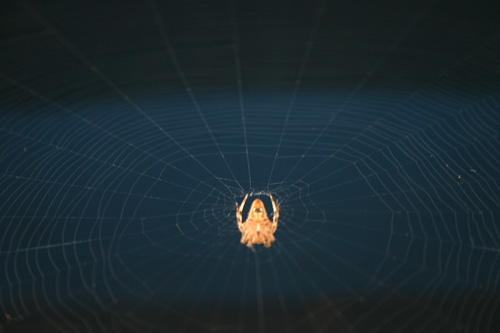
The Oklahoma state parks seem to be very nicely managed and maintained, more so than some of our Texas ones. I loved that they had litter bags to help people keep the trails clean. My only complaint was that they didn’t offer any recycling options for bottles or cans anywhere. We kept our recyclables and brought them back to Texas with us. Green points earned!
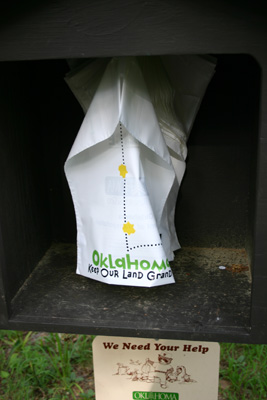 I loved the bark of the pine trees at Robber’s Cave.
I loved the bark of the pine trees at Robber’s Cave.
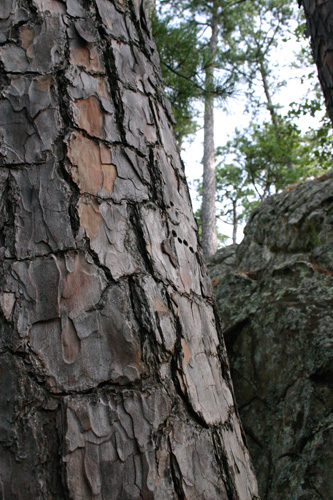 All along the highways and in the state park itself, the beautiful but very invasive mimosa silk tree could be seen. I have a close-up of the flower, but I felt too guilty about admiring the beauty to post it. Bad invasive, bad!
All along the highways and in the state park itself, the beautiful but very invasive mimosa silk tree could be seen. I have a close-up of the flower, but I felt too guilty about admiring the beauty to post it. Bad invasive, bad!
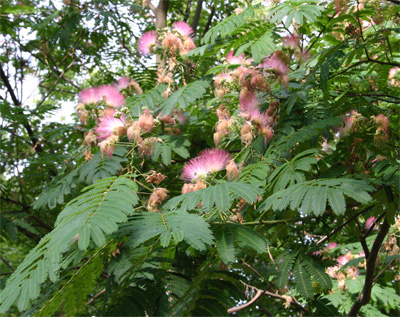 At least it’s prettier than the invasive Chinaberry all over Austin.
At least it’s prettier than the invasive Chinaberry all over Austin.
The Austin Pond Society Pond Tour was this weekend. I have lots of pictures to post over the next couple of days!

 And of our three swallowtail caterpillars happily munching away before we left, we found one chrysalis, so we’ll try to monitor it for butterfly-ness. Of course, it’s in a place that is very hard to get a picture, and it’s also in a place that the butterfly will have a hard time getting out of without our help.
And of our three swallowtail caterpillars happily munching away before we left, we found one chrysalis, so we’ll try to monitor it for butterfly-ness. Of course, it’s in a place that is very hard to get a picture, and it’s also in a place that the butterfly will have a hard time getting out of without our help. 
 The cantaloupes will be in a raised garden bed, grown vertically on a trellis. All in all, we’ll have three raised veggie beds (for now, haha). The cantaloupes will be in one, along with corn and some marigolds, and sugar pumpkins will be in another, with some more corn. The third bed will be prepared for yummy fall planting goodness. The third bed was made for me by my kids this weekend, their first project working with drills and saws and whatnot!
The cantaloupes will be in a raised garden bed, grown vertically on a trellis. All in all, we’ll have three raised veggie beds (for now, haha). The cantaloupes will be in one, along with corn and some marigolds, and sugar pumpkins will be in another, with some more corn. The third bed will be prepared for yummy fall planting goodness. The third bed was made for me by my kids this weekend, their first project working with drills and saws and whatnot! To prepare the area, we dug out the grass. It was dead, so other than dealing with the hard soil, it was no loss and only somewhat of a pain. Then, with the frames in place, I mixed in compost into the existing soil. I expect some plant roots to extend into that soil, so I wanted to enrich it somewhat. How hard was the soil? Casualty, one shovel.
To prepare the area, we dug out the grass. It was dead, so other than dealing with the hard soil, it was no loss and only somewhat of a pain. Then, with the frames in place, I mixed in compost into the existing soil. I expect some plant roots to extend into that soil, so I wanted to enrich it somewhat. How hard was the soil? Casualty, one shovel.


 Because someone at NG told me that peat moss can be a pain to get wet at first, I decided to wet down the soil well and plant tomorrow. Sure enough, I had to work with the peat moss in a big soup of mud to get it to soak in the water. Then I really did feel I was creating a magical potion! Tomorrow will be a good planting day. First I’ll get the trellis wires in place and the grid. Then in will go the cantaloupes and marigolds and some corn seeds.
Because someone at NG told me that peat moss can be a pain to get wet at first, I decided to wet down the soil well and plant tomorrow. Sure enough, I had to work with the peat moss in a big soup of mud to get it to soak in the water. Then I really did feel I was creating a magical potion! Tomorrow will be a good planting day. First I’ll get the trellis wires in place and the grid. Then in will go the cantaloupes and marigolds and some corn seeds. Side story… While I was digging the soil for the frames, I found a weird, soft little tube. At first I thought that it was, pardon me, some old dog poop. But then it split open, and a spider carcass fell out. Squeal. And then lots of little spiders came out and crawled over the spider carcass. Shriek! While I was wondering whether they had eaten the spider, more horrors awaited me… the legs of a gigantic spider appeared. And they MOVED. And more baby spiders crawled out and over the legs… By now, I’d made loud enough noises that the kids came running over. And finally the whole spider slid out, and it was the biggest spider I’d ever seen in my yard. Yes, tarantulas are even bigger, but I haven’t seen one as a resident yet. Despite my startled reaction to the sudden appearance of this spider and her babies, I find her beautiful. Can you see some of her babies in this picture?
Side story… While I was digging the soil for the frames, I found a weird, soft little tube. At first I thought that it was, pardon me, some old dog poop. But then it split open, and a spider carcass fell out. Squeal. And then lots of little spiders came out and crawled over the spider carcass. Shriek! While I was wondering whether they had eaten the spider, more horrors awaited me… the legs of a gigantic spider appeared. And they MOVED. And more baby spiders crawled out and over the legs… By now, I’d made loud enough noises that the kids came running over. And finally the whole spider slid out, and it was the biggest spider I’d ever seen in my yard. Yes, tarantulas are even bigger, but I haven’t seen one as a resident yet. Despite my startled reaction to the sudden appearance of this spider and her babies, I find her beautiful. Can you see some of her babies in this picture?



 I loved the bark of the pine trees at Robber’s Cave.
I loved the bark of the pine trees at Robber’s Cave.

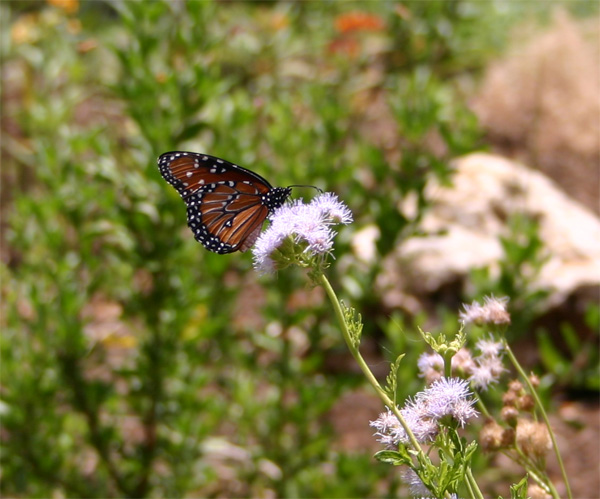
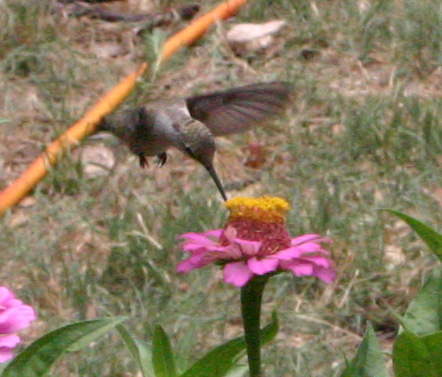 How can you help? If you have a garden, especially an organic one, you are probably already doing tons to help the populations of bees and other pollinators. But Pollinators Week for me is an excuse to go out and buy a native plant just for the sake of the wildlife, so as soon as I finish this blog entry, the boys and I are going to
How can you help? If you have a garden, especially an organic one, you are probably already doing tons to help the populations of bees and other pollinators. But Pollinators Week for me is an excuse to go out and buy a native plant just for the sake of the wildlife, so as soon as I finish this blog entry, the boys and I are going to 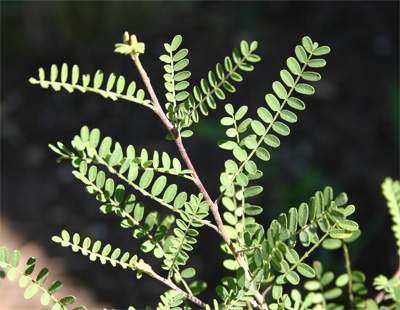
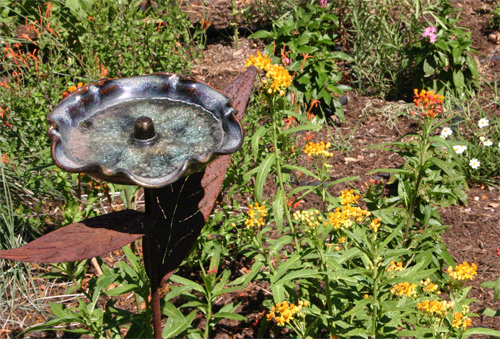
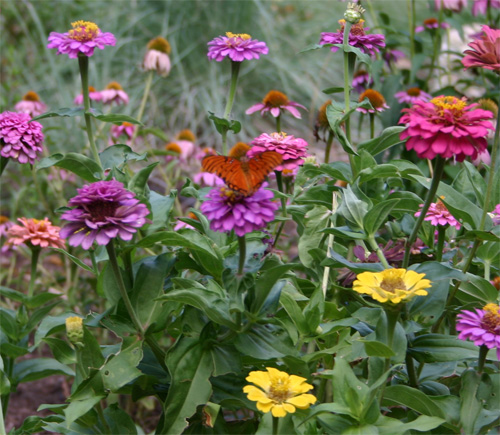
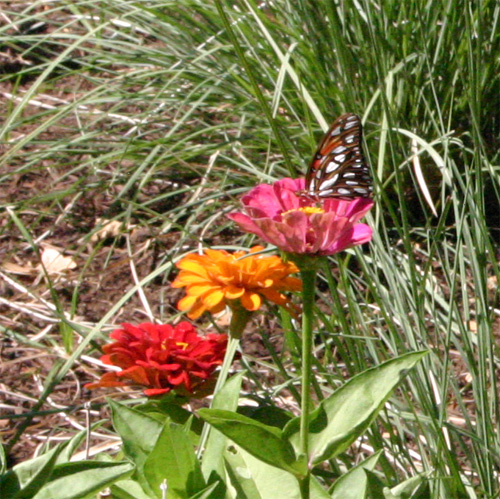
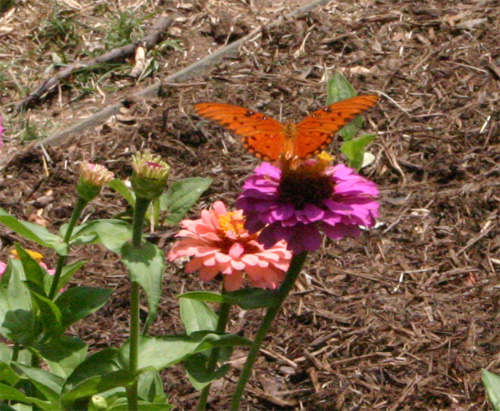 Ah, here’s one of my absolute favorites of the Texas natives, the wafer ash, or hop tree (Ptelea trifoliata). It can be hard to find in a nursery, but it’s easy to grow from seed, and they’re all over. Our dogs ate the top off our first one, and it amazingly grew back, the determined little thing. The wafer ash is a host plant of the giant swallowtail and tiger swallowtail. It’s part of the citrus family, and it’s one time that leaves of three (trifoliata) are a good thing. They have nothing to do with poison ivy, by the way, so get that out of your mind!
Ah, here’s one of my absolute favorites of the Texas natives, the wafer ash, or hop tree (Ptelea trifoliata). It can be hard to find in a nursery, but it’s easy to grow from seed, and they’re all over. Our dogs ate the top off our first one, and it amazingly grew back, the determined little thing. The wafer ash is a host plant of the giant swallowtail and tiger swallowtail. It’s part of the citrus family, and it’s one time that leaves of three (trifoliata) are a good thing. They have nothing to do with poison ivy, by the way, so get that out of your mind!